HSH725: Critical Appraisal of Two Nursing Research Articles
VerifiedAdded on 2022/08/22
|32
|5051
|40
Report
AI Summary
This report presents a critical appraisal of two research articles, one quantitative and one qualitative, using the Critical Appraisal Skills Programme (CASP) tool. The quantitative study, by Opie et al. (2019), examined the impact of promoting fruit and vegetable consumption on discretionary food intake, employing a randomized controlled trial. The appraisal assesses the study's methodology, including participant selection, intervention design, and statistical analysis, based on the CASP checklist for randomized controlled trials. The qualitative study, by Youngwanichsetha and Phumdoung (2016), explored the experiences of blood glucose self-monitoring among pregnant women with gestational diabetes mellitus, utilizing a semi-structured interview approach. The appraisal evaluates the study's aims, methodology, participant recruitment, data collection, and ethical considerations, based on the CASP checklist for qualitative research. The report also addresses ethical issues in both studies, referencing the National Statement on Ethical Conduct in Human Research. The findings of each study are summarized, highlighting their significance and implications for healthcare practice. The report concludes with an overall assessment of the strengths and weaknesses of each study, providing a comprehensive evaluation of the research articles.
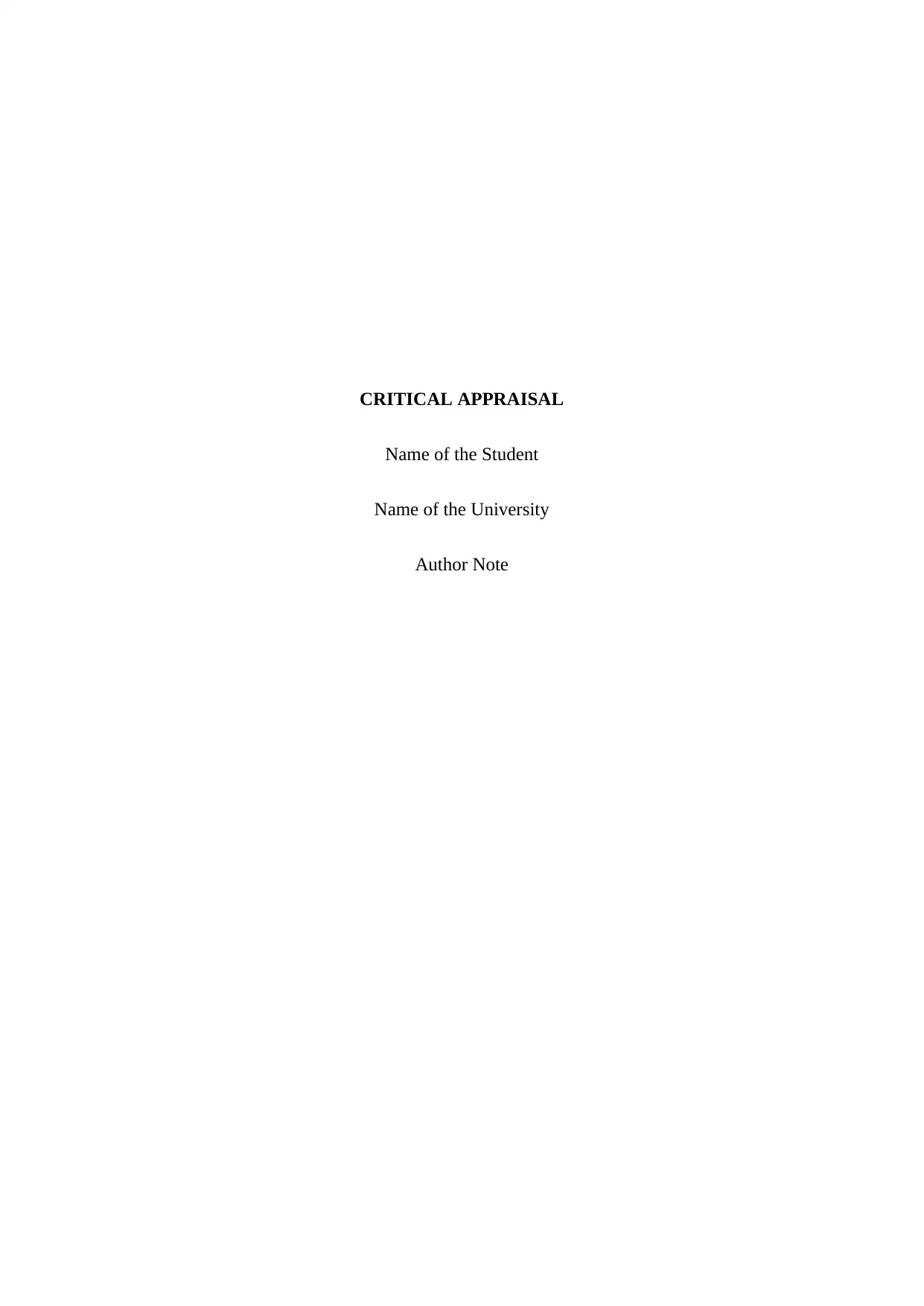
CRITICAL APPRAISAL
Name of the Student
Name of the University
Author Note
Name of the Student
Name of the University
Author Note
Paraphrase This Document
Need a fresh take? Get an instant paraphrase of this document with our AI Paraphraser

Table of Contents
Introduction................................................................................................................................2
Tool Selection............................................................................................................................2
Critical appraisal........................................................................................................................3
Quantitative research study....................................................................................................3
Qualitative research study......................................................................................................5
Ethical issues..............................................................................................................................8
Summary....................................................................................................................................9
References................................................................................................................................11
Appendix 1...............................................................................................................................12
Appendix 2...............................................................................................................................12
Introduction................................................................................................................................2
Tool Selection............................................................................................................................2
Critical appraisal........................................................................................................................3
Quantitative research study....................................................................................................3
Qualitative research study......................................................................................................5
Ethical issues..............................................................................................................................8
Summary....................................................................................................................................9
References................................................................................................................................11
Appendix 1...............................................................................................................................12
Appendix 2...............................................................................................................................12

Introduction
This paper will follow the process of critical appraisal for two papers by analysing the
strength, weakness, and understanding of the social impact in various fields (Marcus 2018).
Any article associated with a critical appraisal has been found to play an important role in the
Evidence-based practices associated with various research studies. This paper will critically
appraise two research papers, qualitative and quantitative respectively. One quantitative study
and one qualitative study will be critically appraised in this paper involving the critical
appraisal checklists available online (CASP tool). The standards and quality of the papers are
to be determined by the research checklist used for the study.
Tool Selection
Opie et al. (2019) have performed a randomized controlled trial associated with the
discretion in food consumption changes while the promotion of vegetables and food. This
paper used the ShopSmart study randomized controlled trial in order to calculate the mean
and standard deviations associated with the P values for quantitative analysis of the chosen
topic. The mediatory variable analysis was done with eleven variables, which made it a
quantitative study. CASP (Critical Appraisal Skill Programme) has been used for the critical
appraisal of this quantitative paper. RCT has been used for this study because control group
and intervention group were selected for this study. Out of the selected participants, one
group has been kept as control and the other group has been studied for the increase in
consumption of vegetables and food after their promotion in the diet and consuming less
discretionary food after this intervention is applied.
Youngwanichsetha and Phumdoung (2016) use a semistructured interview to analyse
the experience of blood glucose self-monitoring among pregnant women in gestational
diabetes mellitus in a qualitative way. The use of semi-structured in this research study has
made it qualitative and thus involved the use of the CASP tool qualitative checklist in this
study.
This paper will follow the process of critical appraisal for two papers by analysing the
strength, weakness, and understanding of the social impact in various fields (Marcus 2018).
Any article associated with a critical appraisal has been found to play an important role in the
Evidence-based practices associated with various research studies. This paper will critically
appraise two research papers, qualitative and quantitative respectively. One quantitative study
and one qualitative study will be critically appraised in this paper involving the critical
appraisal checklists available online (CASP tool). The standards and quality of the papers are
to be determined by the research checklist used for the study.
Tool Selection
Opie et al. (2019) have performed a randomized controlled trial associated with the
discretion in food consumption changes while the promotion of vegetables and food. This
paper used the ShopSmart study randomized controlled trial in order to calculate the mean
and standard deviations associated with the P values for quantitative analysis of the chosen
topic. The mediatory variable analysis was done with eleven variables, which made it a
quantitative study. CASP (Critical Appraisal Skill Programme) has been used for the critical
appraisal of this quantitative paper. RCT has been used for this study because control group
and intervention group were selected for this study. Out of the selected participants, one
group has been kept as control and the other group has been studied for the increase in
consumption of vegetables and food after their promotion in the diet and consuming less
discretionary food after this intervention is applied.
Youngwanichsetha and Phumdoung (2016) use a semistructured interview to analyse
the experience of blood glucose self-monitoring among pregnant women in gestational
diabetes mellitus in a qualitative way. The use of semi-structured in this research study has
made it qualitative and thus involved the use of the CASP tool qualitative checklist in this
study.
⊘ This is a preview!⊘
Do you want full access?
Subscribe today to unlock all pages.

Trusted by 1+ million students worldwide
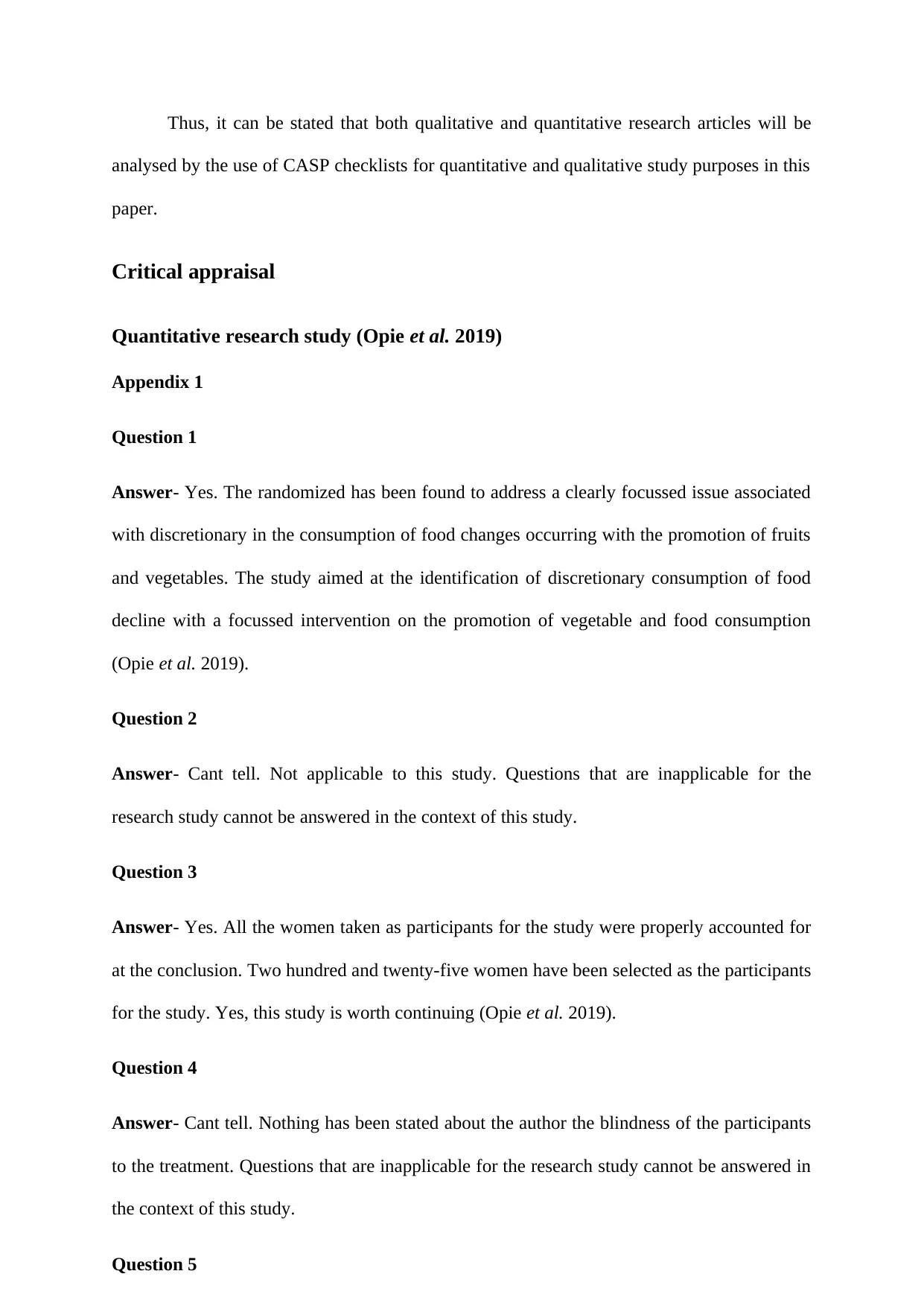
Thus, it can be stated that both qualitative and quantitative research articles will be
analysed by the use of CASP checklists for quantitative and qualitative study purposes in this
paper.
Critical appraisal
Quantitative research study (Opie et al. 2019)
Appendix 1
Question 1
Answer- Yes. The randomized has been found to address a clearly focussed issue associated
with discretionary in the consumption of food changes occurring with the promotion of fruits
and vegetables. The study aimed at the identification of discretionary consumption of food
decline with a focussed intervention on the promotion of vegetable and food consumption
(Opie et al. 2019).
Question 2
Answer- Cant tell. Not applicable to this study. Questions that are inapplicable for the
research study cannot be answered in the context of this study.
Question 3
Answer- Yes. All the women taken as participants for the study were properly accounted for
at the conclusion. Two hundred and twenty-five women have been selected as the participants
for the study. Yes, this study is worth continuing (Opie et al. 2019).
Question 4
Answer- Cant tell. Nothing has been stated about the author the blindness of the participants
to the treatment. Questions that are inapplicable for the research study cannot be answered in
the context of this study.
Question 5
analysed by the use of CASP checklists for quantitative and qualitative study purposes in this
paper.
Critical appraisal
Quantitative research study (Opie et al. 2019)
Appendix 1
Question 1
Answer- Yes. The randomized has been found to address a clearly focussed issue associated
with discretionary in the consumption of food changes occurring with the promotion of fruits
and vegetables. The study aimed at the identification of discretionary consumption of food
decline with a focussed intervention on the promotion of vegetable and food consumption
(Opie et al. 2019).
Question 2
Answer- Cant tell. Not applicable to this study. Questions that are inapplicable for the
research study cannot be answered in the context of this study.
Question 3
Answer- Yes. All the women taken as participants for the study were properly accounted for
at the conclusion. Two hundred and twenty-five women have been selected as the participants
for the study. Yes, this study is worth continuing (Opie et al. 2019).
Question 4
Answer- Cant tell. Nothing has been stated about the author the blindness of the participants
to the treatment. Questions that are inapplicable for the research study cannot be answered in
the context of this study.
Question 5
Paraphrase This Document
Need a fresh take? Get an instant paraphrase of this document with our AI Paraphraser
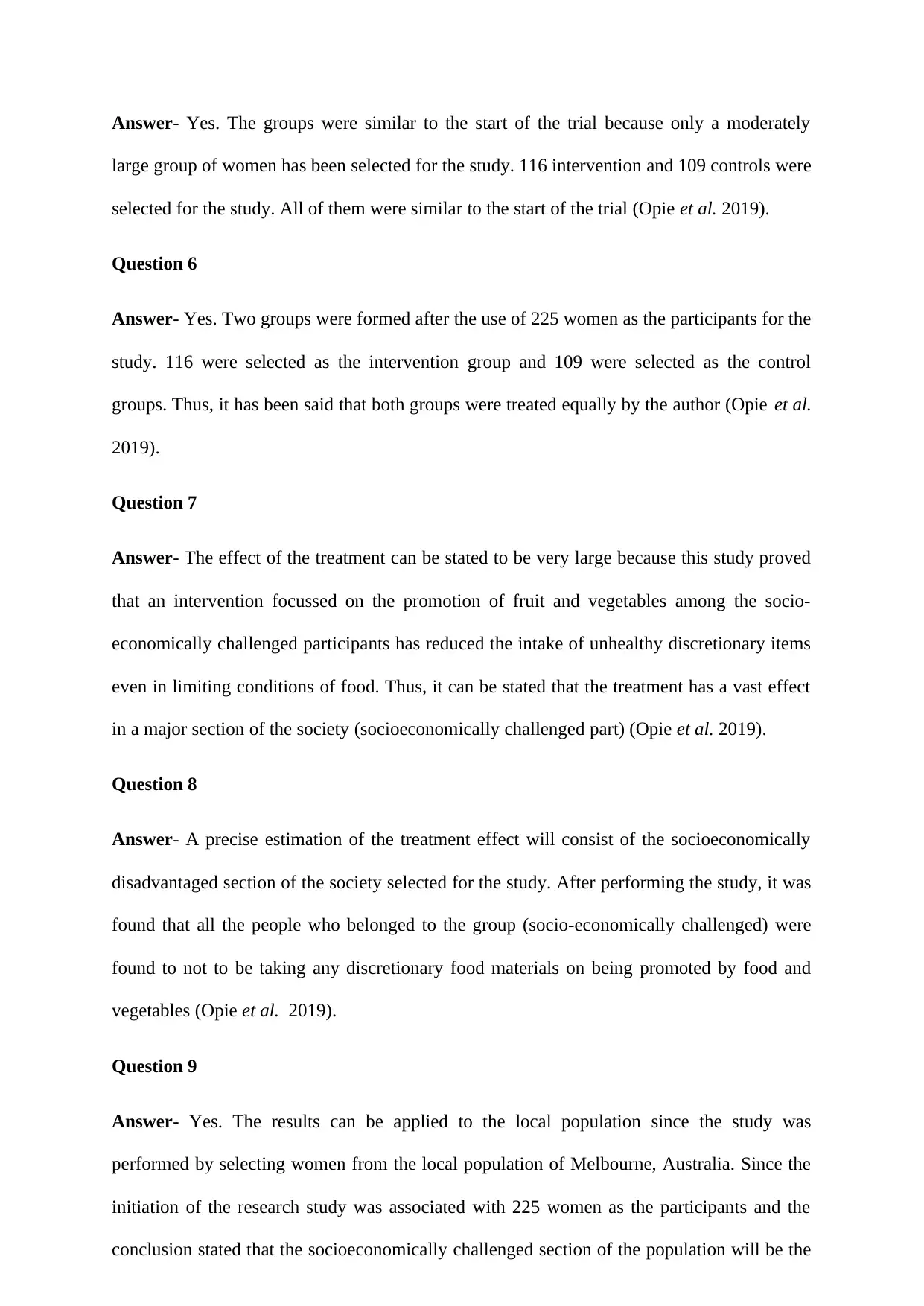
Answer- Yes. The groups were similar to the start of the trial because only a moderately
large group of women has been selected for the study. 116 intervention and 109 controls were
selected for the study. All of them were similar to the start of the trial (Opie et al. 2019).
Question 6
Answer- Yes. Two groups were formed after the use of 225 women as the participants for the
study. 116 were selected as the intervention group and 109 were selected as the control
groups. Thus, it has been said that both groups were treated equally by the author (Opie et al.
2019).
Question 7
Answer- The effect of the treatment can be stated to be very large because this study proved
that an intervention focussed on the promotion of fruit and vegetables among the socio-
economically challenged participants has reduced the intake of unhealthy discretionary items
even in limiting conditions of food. Thus, it can be stated that the treatment has a vast effect
in a major section of the society (socioeconomically challenged part) (Opie et al. 2019).
Question 8
Answer- A precise estimation of the treatment effect will consist of the socioeconomically
disadvantaged section of the society selected for the study. After performing the study, it was
found that all the people who belonged to the group (socio-economically challenged) were
found to not to be taking any discretionary food materials on being promoted by food and
vegetables (Opie et al. 2019).
Question 9
Answer- Yes. The results can be applied to the local population since the study was
performed by selecting women from the local population of Melbourne, Australia. Since the
initiation of the research study was associated with 225 women as the participants and the
conclusion stated that the socioeconomically challenged section of the population will be the
large group of women has been selected for the study. 116 intervention and 109 controls were
selected for the study. All of them were similar to the start of the trial (Opie et al. 2019).
Question 6
Answer- Yes. Two groups were formed after the use of 225 women as the participants for the
study. 116 were selected as the intervention group and 109 were selected as the control
groups. Thus, it has been said that both groups were treated equally by the author (Opie et al.
2019).
Question 7
Answer- The effect of the treatment can be stated to be very large because this study proved
that an intervention focussed on the promotion of fruit and vegetables among the socio-
economically challenged participants has reduced the intake of unhealthy discretionary items
even in limiting conditions of food. Thus, it can be stated that the treatment has a vast effect
in a major section of the society (socioeconomically challenged part) (Opie et al. 2019).
Question 8
Answer- A precise estimation of the treatment effect will consist of the socioeconomically
disadvantaged section of the society selected for the study. After performing the study, it was
found that all the people who belonged to the group (socio-economically challenged) were
found to not to be taking any discretionary food materials on being promoted by food and
vegetables (Opie et al. 2019).
Question 9
Answer- Yes. The results can be applied to the local population since the study was
performed by selecting women from the local population of Melbourne, Australia. Since the
initiation of the research study was associated with 225 women as the participants and the
conclusion stated that the socioeconomically challenged section of the population will be the
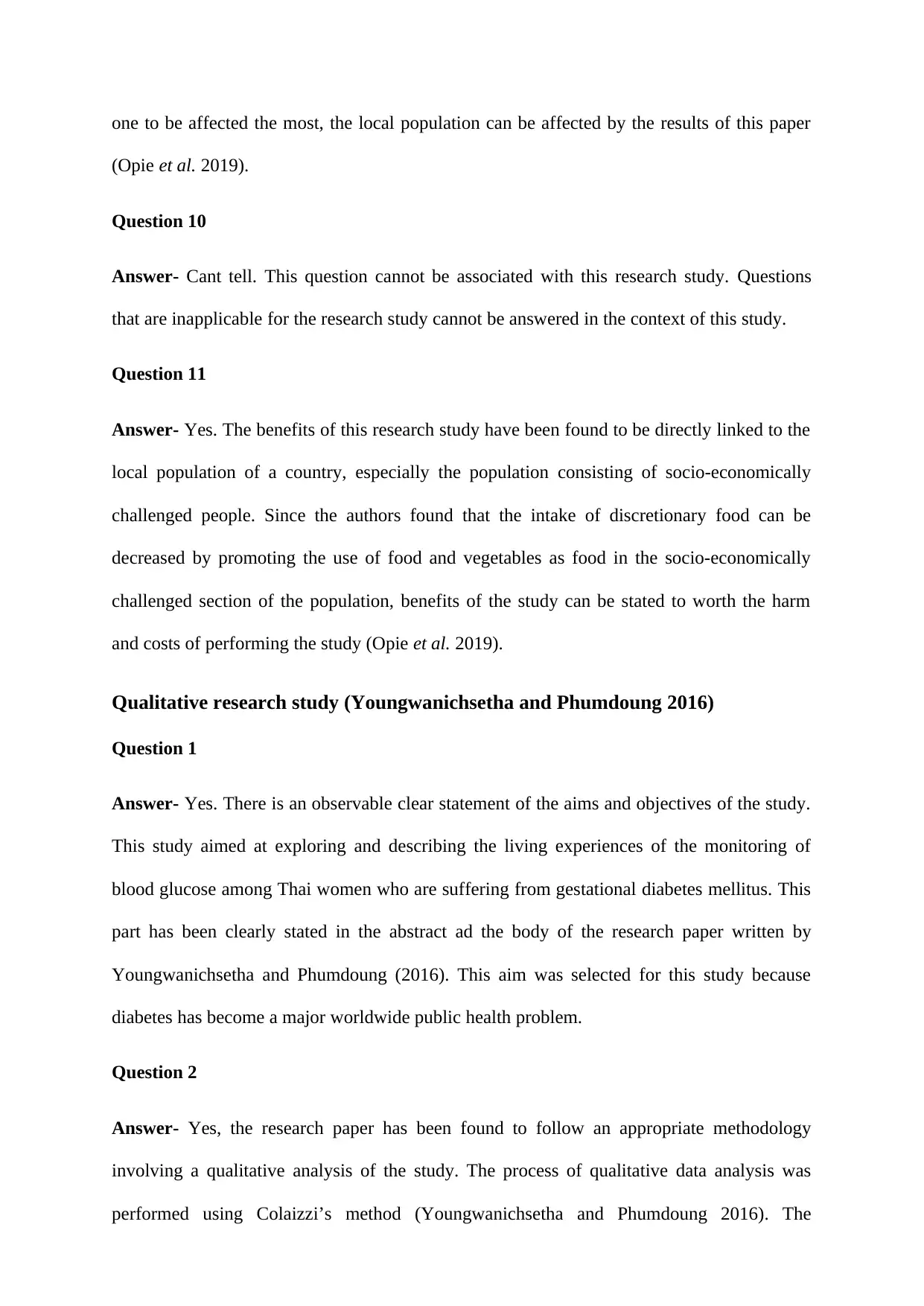
one to be affected the most, the local population can be affected by the results of this paper
(Opie et al. 2019).
Question 10
Answer- Cant tell. This question cannot be associated with this research study. Questions
that are inapplicable for the research study cannot be answered in the context of this study.
Question 11
Answer- Yes. The benefits of this research study have been found to be directly linked to the
local population of a country, especially the population consisting of socio-economically
challenged people. Since the authors found that the intake of discretionary food can be
decreased by promoting the use of food and vegetables as food in the socio-economically
challenged section of the population, benefits of the study can be stated to worth the harm
and costs of performing the study (Opie et al. 2019).
Qualitative research study (Youngwanichsetha and Phumdoung 2016)
Question 1
Answer- Yes. There is an observable clear statement of the aims and objectives of the study.
This study aimed at exploring and describing the living experiences of the monitoring of
blood glucose among Thai women who are suffering from gestational diabetes mellitus. This
part has been clearly stated in the abstract ad the body of the research paper written by
Youngwanichsetha and Phumdoung (2016). This aim was selected for this study because
diabetes has become a major worldwide public health problem.
Question 2
Answer- Yes, the research paper has been found to follow an appropriate methodology
involving a qualitative analysis of the study. The process of qualitative data analysis was
performed using Colaizzi’s method (Youngwanichsetha and Phumdoung 2016). The
(Opie et al. 2019).
Question 10
Answer- Cant tell. This question cannot be associated with this research study. Questions
that are inapplicable for the research study cannot be answered in the context of this study.
Question 11
Answer- Yes. The benefits of this research study have been found to be directly linked to the
local population of a country, especially the population consisting of socio-economically
challenged people. Since the authors found that the intake of discretionary food can be
decreased by promoting the use of food and vegetables as food in the socio-economically
challenged section of the population, benefits of the study can be stated to worth the harm
and costs of performing the study (Opie et al. 2019).
Qualitative research study (Youngwanichsetha and Phumdoung 2016)
Question 1
Answer- Yes. There is an observable clear statement of the aims and objectives of the study.
This study aimed at exploring and describing the living experiences of the monitoring of
blood glucose among Thai women who are suffering from gestational diabetes mellitus. This
part has been clearly stated in the abstract ad the body of the research paper written by
Youngwanichsetha and Phumdoung (2016). This aim was selected for this study because
diabetes has become a major worldwide public health problem.
Question 2
Answer- Yes, the research paper has been found to follow an appropriate methodology
involving a qualitative analysis of the study. The process of qualitative data analysis was
performed using Colaizzi’s method (Youngwanichsetha and Phumdoung 2016). The
⊘ This is a preview!⊘
Do you want full access?
Subscribe today to unlock all pages.

Trusted by 1+ million students worldwide
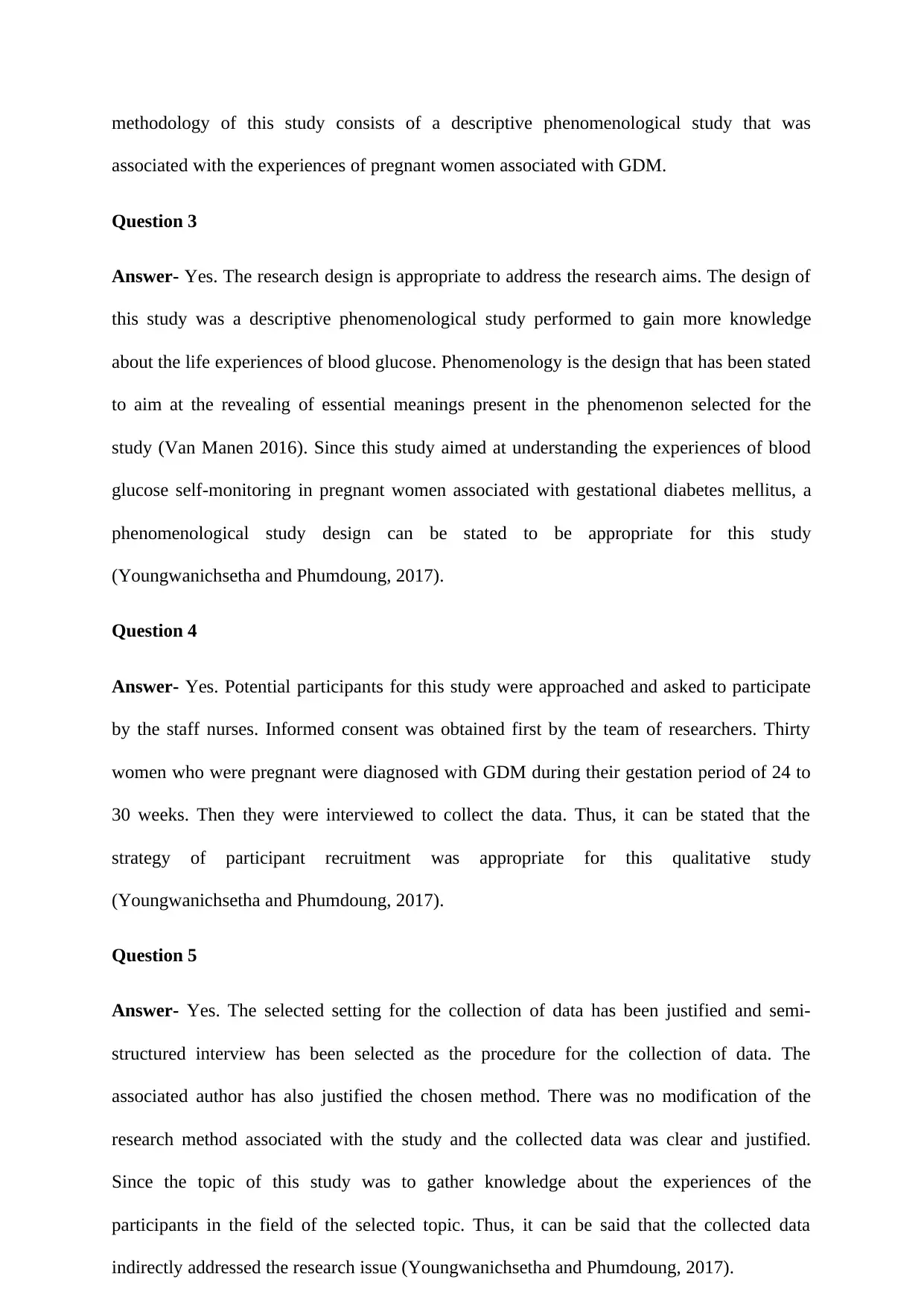
methodology of this study consists of a descriptive phenomenological study that was
associated with the experiences of pregnant women associated with GDM.
Question 3
Answer- Yes. The research design is appropriate to address the research aims. The design of
this study was a descriptive phenomenological study performed to gain more knowledge
about the life experiences of blood glucose. Phenomenology is the design that has been stated
to aim at the revealing of essential meanings present in the phenomenon selected for the
study (Van Manen 2016). Since this study aimed at understanding the experiences of blood
glucose self-monitoring in pregnant women associated with gestational diabetes mellitus, a
phenomenological study design can be stated to be appropriate for this study
(Youngwanichsetha and Phumdoung, 2017).
Question 4
Answer- Yes. Potential participants for this study were approached and asked to participate
by the staff nurses. Informed consent was obtained first by the team of researchers. Thirty
women who were pregnant were diagnosed with GDM during their gestation period of 24 to
30 weeks. Then they were interviewed to collect the data. Thus, it can be stated that the
strategy of participant recruitment was appropriate for this qualitative study
(Youngwanichsetha and Phumdoung, 2017).
Question 5
Answer- Yes. The selected setting for the collection of data has been justified and semi-
structured interview has been selected as the procedure for the collection of data. The
associated author has also justified the chosen method. There was no modification of the
research method associated with the study and the collected data was clear and justified.
Since the topic of this study was to gather knowledge about the experiences of the
participants in the field of the selected topic. Thus, it can be said that the collected data
indirectly addressed the research issue (Youngwanichsetha and Phumdoung, 2017).
associated with the experiences of pregnant women associated with GDM.
Question 3
Answer- Yes. The research design is appropriate to address the research aims. The design of
this study was a descriptive phenomenological study performed to gain more knowledge
about the life experiences of blood glucose. Phenomenology is the design that has been stated
to aim at the revealing of essential meanings present in the phenomenon selected for the
study (Van Manen 2016). Since this study aimed at understanding the experiences of blood
glucose self-monitoring in pregnant women associated with gestational diabetes mellitus, a
phenomenological study design can be stated to be appropriate for this study
(Youngwanichsetha and Phumdoung, 2017).
Question 4
Answer- Yes. Potential participants for this study were approached and asked to participate
by the staff nurses. Informed consent was obtained first by the team of researchers. Thirty
women who were pregnant were diagnosed with GDM during their gestation period of 24 to
30 weeks. Then they were interviewed to collect the data. Thus, it can be stated that the
strategy of participant recruitment was appropriate for this qualitative study
(Youngwanichsetha and Phumdoung, 2017).
Question 5
Answer- Yes. The selected setting for the collection of data has been justified and semi-
structured interview has been selected as the procedure for the collection of data. The
associated author has also justified the chosen method. There was no modification of the
research method associated with the study and the collected data was clear and justified.
Since the topic of this study was to gather knowledge about the experiences of the
participants in the field of the selected topic. Thus, it can be said that the collected data
indirectly addressed the research issue (Youngwanichsetha and Phumdoung, 2017).
Paraphrase This Document
Need a fresh take? Get an instant paraphrase of this document with our AI Paraphraser

Question 6
Answer- No. There is no statement in the study that states that the researchers critically
examined their roles in discussing the potential bias and influences during the formulation of
questions and collection of data. However, the researchers successfully conducted the
interview as per the research design and also responded to the events associated with the
study (Youngwanichsetha and Phumdoung, 2017).
Question 7
Answer- Yes. All the ethical issues were considered for the study since there are sufficient
details for the explanation of the research design (interviews) to the participants (women) in
order to assess the ethical standards. The Institutional Review Boards and ethics committees
of the Faculty of Nursing and Faculty of Medicine of the associated university approved the
project and collection of data in order to get ethical approval for the study. Informed consent
was then obtained by the team of researchers from the participants before starting the
research (Youngwanichsetha and Phumdoung, 2017).
Question 8
Answer- Yes. The analysis of data can be stated to be sufficiently rigorous. The analysis of
data showed that pregnant women participants who were undergoing BGSM have been
experiencing satisfaction with their pregnancy condition. A major section of them was found
to achieve better glycemic control without any complications with diabetes. An in-depth
discussion of the analysis process was performed in this research study and sufficient data in
the form of interview results has been placed in order to support the findings
(Youngwanichsetha and Phumdoung, 2017).
Question 9
Answer- The findings showed that the participants were worried about diabetes and doing
blood tests after they were diagnosed with diabetes. Then they were found to try to control
Answer- No. There is no statement in the study that states that the researchers critically
examined their roles in discussing the potential bias and influences during the formulation of
questions and collection of data. However, the researchers successfully conducted the
interview as per the research design and also responded to the events associated with the
study (Youngwanichsetha and Phumdoung, 2017).
Question 7
Answer- Yes. All the ethical issues were considered for the study since there are sufficient
details for the explanation of the research design (interviews) to the participants (women) in
order to assess the ethical standards. The Institutional Review Boards and ethics committees
of the Faculty of Nursing and Faculty of Medicine of the associated university approved the
project and collection of data in order to get ethical approval for the study. Informed consent
was then obtained by the team of researchers from the participants before starting the
research (Youngwanichsetha and Phumdoung, 2017).
Question 8
Answer- Yes. The analysis of data can be stated to be sufficiently rigorous. The analysis of
data showed that pregnant women participants who were undergoing BGSM have been
experiencing satisfaction with their pregnancy condition. A major section of them was found
to achieve better glycemic control without any complications with diabetes. An in-depth
discussion of the analysis process was performed in this research study and sufficient data in
the form of interview results has been placed in order to support the findings
(Youngwanichsetha and Phumdoung, 2017).
Question 9
Answer- The findings showed that the participants were worried about diabetes and doing
blood tests after they were diagnosed with diabetes. Then they were found to try to control
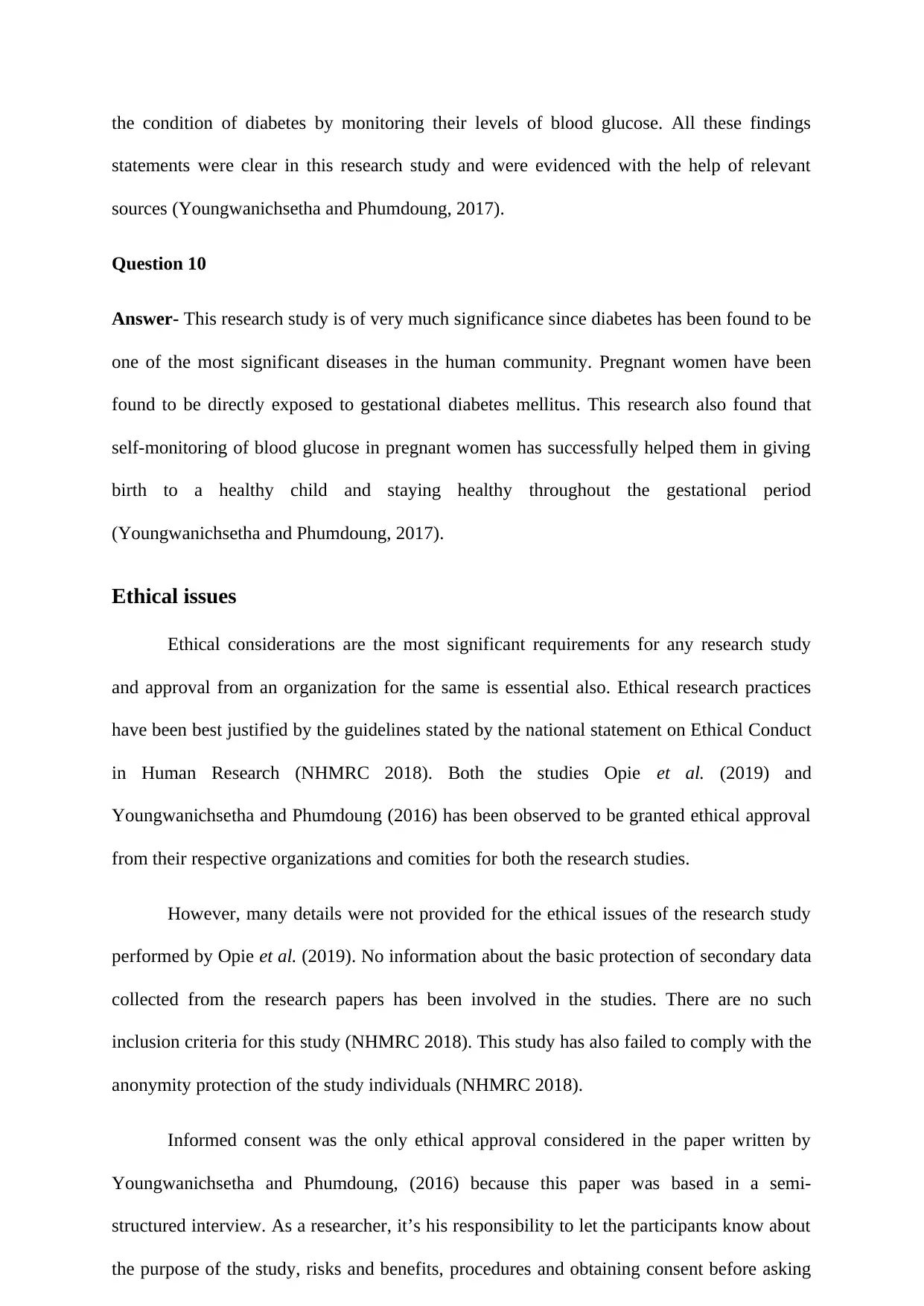
the condition of diabetes by monitoring their levels of blood glucose. All these findings
statements were clear in this research study and were evidenced with the help of relevant
sources (Youngwanichsetha and Phumdoung, 2017).
Question 10
Answer- This research study is of very much significance since diabetes has been found to be
one of the most significant diseases in the human community. Pregnant women have been
found to be directly exposed to gestational diabetes mellitus. This research also found that
self-monitoring of blood glucose in pregnant women has successfully helped them in giving
birth to a healthy child and staying healthy throughout the gestational period
(Youngwanichsetha and Phumdoung, 2017).
Ethical issues
Ethical considerations are the most significant requirements for any research study
and approval from an organization for the same is essential also. Ethical research practices
have been best justified by the guidelines stated by the national statement on Ethical Conduct
in Human Research (NHMRC 2018). Both the studies Opie et al. (2019) and
Youngwanichsetha and Phumdoung (2016) has been observed to be granted ethical approval
from their respective organizations and comities for both the research studies.
However, many details were not provided for the ethical issues of the research study
performed by Opie et al. (2019). No information about the basic protection of secondary data
collected from the research papers has been involved in the studies. There are no such
inclusion criteria for this study (NHMRC 2018). This study has also failed to comply with the
anonymity protection of the study individuals (NHMRC 2018).
Informed consent was the only ethical approval considered in the paper written by
Youngwanichsetha and Phumdoung, (2016) because this paper was based in a semi-
structured interview. As a researcher, it’s his responsibility to let the participants know about
the purpose of the study, risks and benefits, procedures and obtaining consent before asking
statements were clear in this research study and were evidenced with the help of relevant
sources (Youngwanichsetha and Phumdoung, 2017).
Question 10
Answer- This research study is of very much significance since diabetes has been found to be
one of the most significant diseases in the human community. Pregnant women have been
found to be directly exposed to gestational diabetes mellitus. This research also found that
self-monitoring of blood glucose in pregnant women has successfully helped them in giving
birth to a healthy child and staying healthy throughout the gestational period
(Youngwanichsetha and Phumdoung, 2017).
Ethical issues
Ethical considerations are the most significant requirements for any research study
and approval from an organization for the same is essential also. Ethical research practices
have been best justified by the guidelines stated by the national statement on Ethical Conduct
in Human Research (NHMRC 2018). Both the studies Opie et al. (2019) and
Youngwanichsetha and Phumdoung (2016) has been observed to be granted ethical approval
from their respective organizations and comities for both the research studies.
However, many details were not provided for the ethical issues of the research study
performed by Opie et al. (2019). No information about the basic protection of secondary data
collected from the research papers has been involved in the studies. There are no such
inclusion criteria for this study (NHMRC 2018). This study has also failed to comply with the
anonymity protection of the study individuals (NHMRC 2018).
Informed consent was the only ethical approval considered in the paper written by
Youngwanichsetha and Phumdoung, (2016) because this paper was based in a semi-
structured interview. As a researcher, it’s his responsibility to let the participants know about
the purpose of the study, risks and benefits, procedures and obtaining consent before asking
⊘ This is a preview!⊘
Do you want full access?
Subscribe today to unlock all pages.

Trusted by 1+ million students worldwide
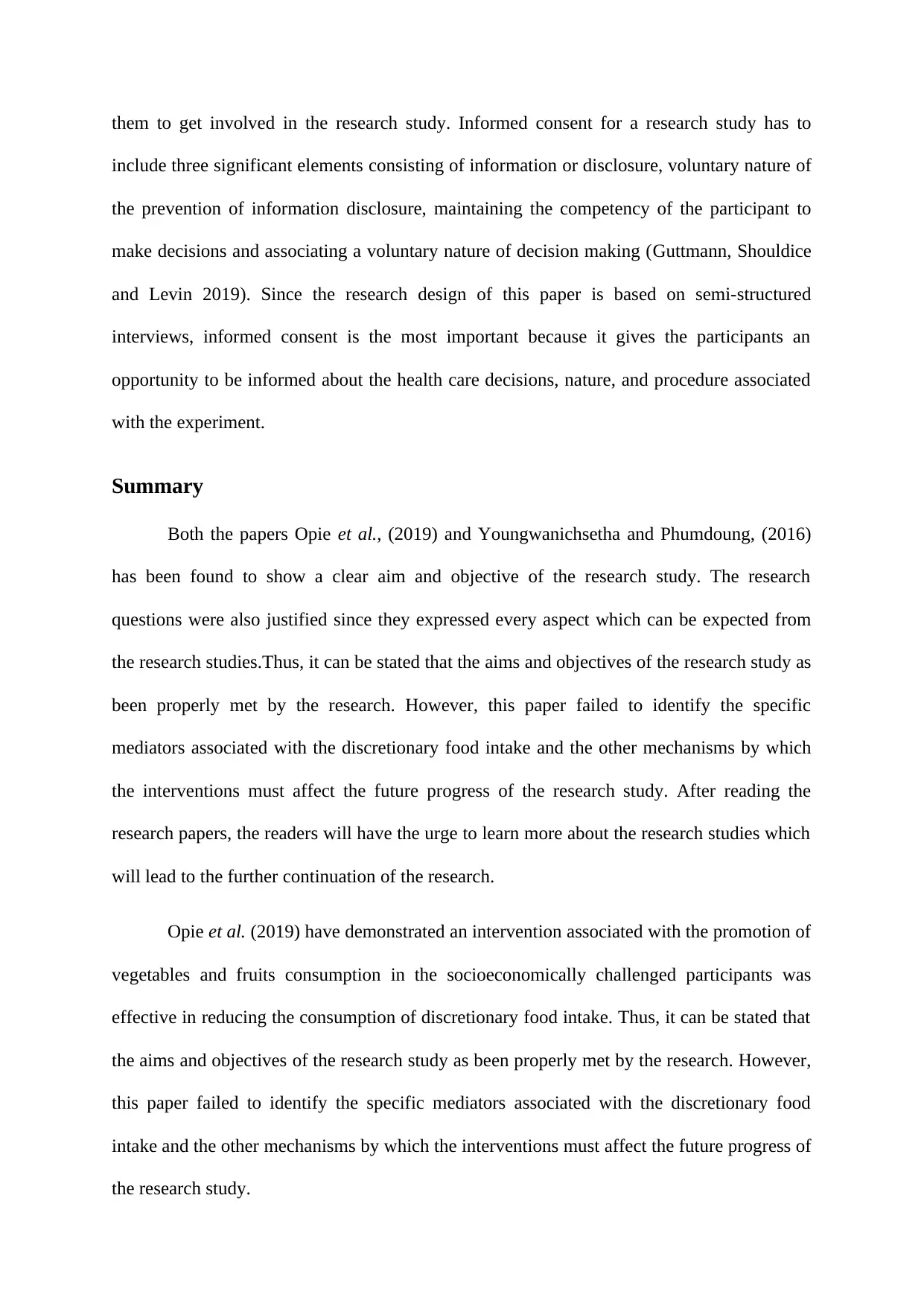
them to get involved in the research study. Informed consent for a research study has to
include three significant elements consisting of information or disclosure, voluntary nature of
the prevention of information disclosure, maintaining the competency of the participant to
make decisions and associating a voluntary nature of decision making (Guttmann, Shouldice
and Levin 2019). Since the research design of this paper is based on semi-structured
interviews, informed consent is the most important because it gives the participants an
opportunity to be informed about the health care decisions, nature, and procedure associated
with the experiment.
Summary
Both the papers Opie et al., (2019) and Youngwanichsetha and Phumdoung, (2016)
has been found to show a clear aim and objective of the research study. The research
questions were also justified since they expressed every aspect which can be expected from
the research studies.Thus, it can be stated that the aims and objectives of the research study as
been properly met by the research. However, this paper failed to identify the specific
mediators associated with the discretionary food intake and the other mechanisms by which
the interventions must affect the future progress of the research study. After reading the
research papers, the readers will have the urge to learn more about the research studies which
will lead to the further continuation of the research.
Opie et al. (2019) have demonstrated an intervention associated with the promotion of
vegetables and fruits consumption in the socioeconomically challenged participants was
effective in reducing the consumption of discretionary food intake. Thus, it can be stated that
the aims and objectives of the research study as been properly met by the research. However,
this paper failed to identify the specific mediators associated with the discretionary food
intake and the other mechanisms by which the interventions must affect the future progress of
the research study.
include three significant elements consisting of information or disclosure, voluntary nature of
the prevention of information disclosure, maintaining the competency of the participant to
make decisions and associating a voluntary nature of decision making (Guttmann, Shouldice
and Levin 2019). Since the research design of this paper is based on semi-structured
interviews, informed consent is the most important because it gives the participants an
opportunity to be informed about the health care decisions, nature, and procedure associated
with the experiment.
Summary
Both the papers Opie et al., (2019) and Youngwanichsetha and Phumdoung, (2016)
has been found to show a clear aim and objective of the research study. The research
questions were also justified since they expressed every aspect which can be expected from
the research studies.Thus, it can be stated that the aims and objectives of the research study as
been properly met by the research. However, this paper failed to identify the specific
mediators associated with the discretionary food intake and the other mechanisms by which
the interventions must affect the future progress of the research study. After reading the
research papers, the readers will have the urge to learn more about the research studies which
will lead to the further continuation of the research.
Opie et al. (2019) have demonstrated an intervention associated with the promotion of
vegetables and fruits consumption in the socioeconomically challenged participants was
effective in reducing the consumption of discretionary food intake. Thus, it can be stated that
the aims and objectives of the research study as been properly met by the research. However,
this paper failed to identify the specific mediators associated with the discretionary food
intake and the other mechanisms by which the interventions must affect the future progress of
the research study.
Paraphrase This Document
Need a fresh take? Get an instant paraphrase of this document with our AI Paraphraser

According to Youngwanichsetha and Phumdoung (2016) women affected with
gestational diabetes have been found to be worried about high blood glucose. Thus they have
been found to use the self-monitoring strategy for blood glucose to overcome and tolerate the
difficulties associated with the study. The findings of this study have been used in order to
guide various nursing practice assessments for blood glucose monitoring during gestational
diabetes. Thus, it can be stated that a good glycaemic control among the pregnant women
affected by gestational diabetes mellitus can be earned by self-blood glucose monitoring
strategy.
Both the articles complied with the study outcomes however, both of them failed to
discuss the existence of statistical biases in their study. Alternatives to the stated procedure
were also not discussed in the studies. Thus, these were the major drawbacks of the research
in both the papers.
gestational diabetes have been found to be worried about high blood glucose. Thus they have
been found to use the self-monitoring strategy for blood glucose to overcome and tolerate the
difficulties associated with the study. The findings of this study have been used in order to
guide various nursing practice assessments for blood glucose monitoring during gestational
diabetes. Thus, it can be stated that a good glycaemic control among the pregnant women
affected by gestational diabetes mellitus can be earned by self-blood glucose monitoring
strategy.
Both the articles complied with the study outcomes however, both of them failed to
discuss the existence of statistical biases in their study. Alternatives to the stated procedure
were also not discussed in the studies. Thus, these were the major drawbacks of the research
in both the papers.
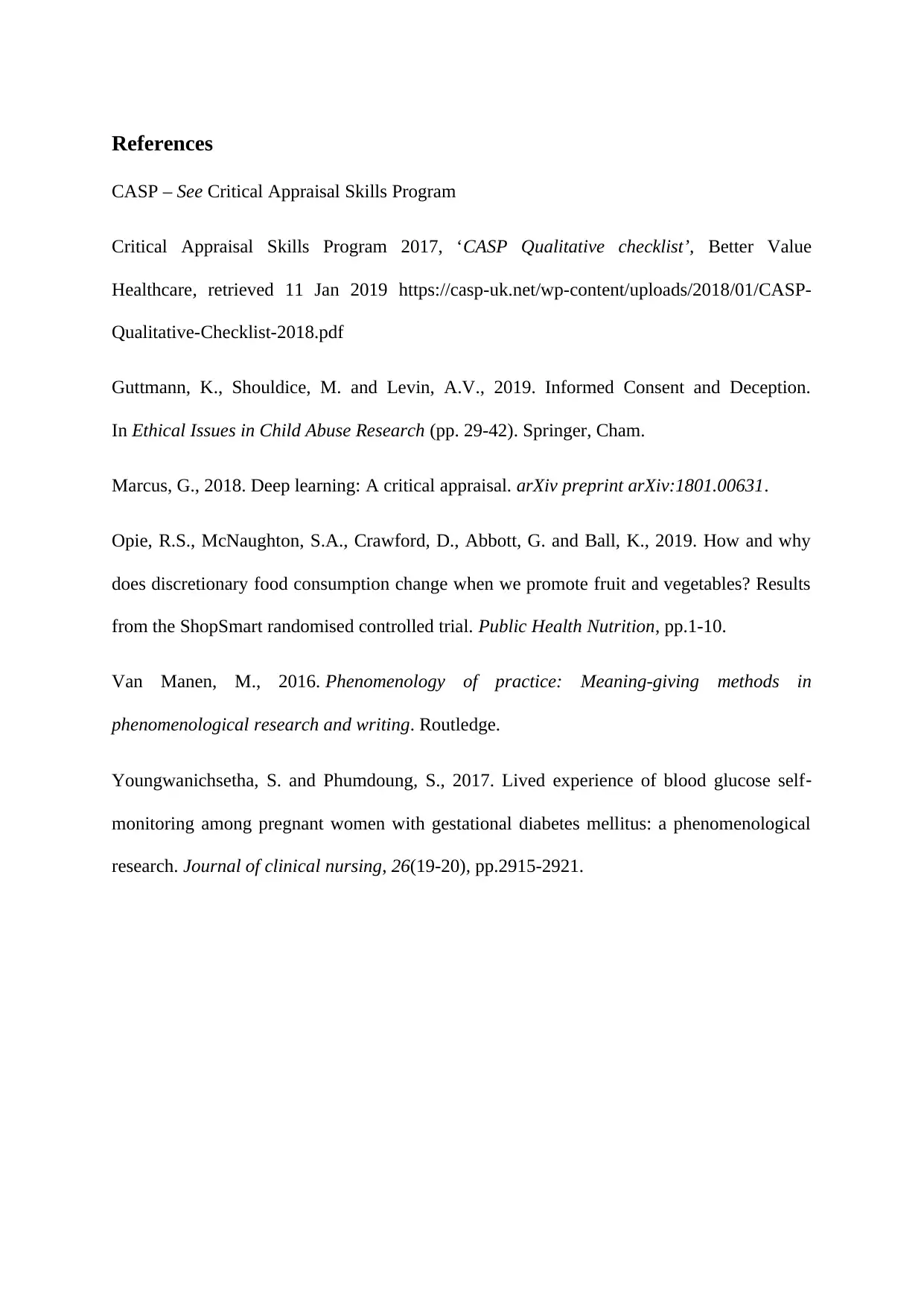
References
CASP – See Critical Appraisal Skills Program
Critical Appraisal Skills Program 2017, ‘CASP Qualitative checklist’, Better Value
Healthcare, retrieved 11 Jan 2019 https://casp-uk.net/wp-content/uploads/2018/01/CASP-
Qualitative-Checklist-2018.pdf
Guttmann, K., Shouldice, M. and Levin, A.V., 2019. Informed Consent and Deception.
In Ethical Issues in Child Abuse Research (pp. 29-42). Springer, Cham.
Marcus, G., 2018. Deep learning: A critical appraisal. arXiv preprint arXiv:1801.00631.
Opie, R.S., McNaughton, S.A., Crawford, D., Abbott, G. and Ball, K., 2019. How and why
does discretionary food consumption change when we promote fruit and vegetables? Results
from the ShopSmart randomised controlled trial. Public Health Nutrition, pp.1-10.
Van Manen, M., 2016. Phenomenology of practice: Meaning-giving methods in
phenomenological research and writing. Routledge.
Youngwanichsetha, S. and Phumdoung, S., 2017. Lived experience of blood glucose self‐
monitoring among pregnant women with gestational diabetes mellitus: a phenomenological
research. Journal of clinical nursing, 26(19-20), pp.2915-2921.
CASP – See Critical Appraisal Skills Program
Critical Appraisal Skills Program 2017, ‘CASP Qualitative checklist’, Better Value
Healthcare, retrieved 11 Jan 2019 https://casp-uk.net/wp-content/uploads/2018/01/CASP-
Qualitative-Checklist-2018.pdf
Guttmann, K., Shouldice, M. and Levin, A.V., 2019. Informed Consent and Deception.
In Ethical Issues in Child Abuse Research (pp. 29-42). Springer, Cham.
Marcus, G., 2018. Deep learning: A critical appraisal. arXiv preprint arXiv:1801.00631.
Opie, R.S., McNaughton, S.A., Crawford, D., Abbott, G. and Ball, K., 2019. How and why
does discretionary food consumption change when we promote fruit and vegetables? Results
from the ShopSmart randomised controlled trial. Public Health Nutrition, pp.1-10.
Van Manen, M., 2016. Phenomenology of practice: Meaning-giving methods in
phenomenological research and writing. Routledge.
Youngwanichsetha, S. and Phumdoung, S., 2017. Lived experience of blood glucose self‐
monitoring among pregnant women with gestational diabetes mellitus: a phenomenological
research. Journal of clinical nursing, 26(19-20), pp.2915-2921.
⊘ This is a preview!⊘
Do you want full access?
Subscribe today to unlock all pages.

Trusted by 1+ million students worldwide
1 out of 32
Related Documents
Your All-in-One AI-Powered Toolkit for Academic Success.
+13062052269
info@desklib.com
Available 24*7 on WhatsApp / Email
![[object Object]](/_next/static/media/star-bottom.7253800d.svg)
Unlock your academic potential
Copyright © 2020–2025 A2Z Services. All Rights Reserved. Developed and managed by ZUCOL.





